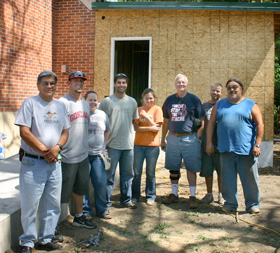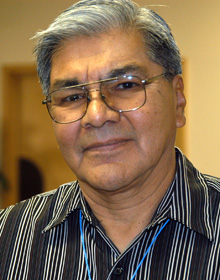Construction project builds community
The project to build a handicap-accessible restroom on the back of First Presbyterian Church in Spalding has fulfilled several dreams for members.
Fund raising for it began in the 1950s and continues. The inside is complete and functional, but the exterior is still being sided with faux brick sheets to match the church.
 |
| Corbett Wheeler, Gonzaga student, Joe Kramarz |
The congregation, which has an average attendance of 15 to 40, is one of six Nez Perce churches in the Presbytery of the Inland Northwest
Founded by missionary Henry Spalding in 1844, the present church was built in 1877 and upgraded in 1936 with brick siding. It’s near the Nez Perce National Historical Park.
Most of the construction was done over four months in the summer of 2006 with Gonzaga University students and a team from Florida.
Fifty years ago, women of the church began saving to build a restroom to replace the outhouse as a way to encourage people to stay longer after church. Nancy Halfmoon, 96, and others helped keep the dream alive.
In the Nez Perce Presbyterian tradition, people attend their family churches, usually where they were baptized. So they may drive 60 miles on a Sunday.
Corbett Wheeler, moderator of the Joint Session of Elders for the six congregations, said when he worked in an auto body shop in Portland, Ore., he attended special services at Nez Perce Presbyterian churches. In 1994, he returned to Kamiah and in 1997, moved to Lapwai.
 |
| Ramp leads to new restroom |
In addition to Spalding, the other five Nez Perce Presbyterian churches are First and Second Presbyterian in Kamiah, Ahsahka, Stites and Meadow Creek.
The vision to build the restroom was picked up recently as part of updating other Nez Perce churches so they are ready to receive young people as they return to the community, Corbett said. In the 1950s and 1960s, many young people were relocated to cities for education, jobs and assimilation.
Part of what he considers a “miracle” is how the project brought together Nez Perce people across divisions between those in churches and local people who are not church members.
It drew Presbyterians from Nez Perce churches, Spokane and Palm Beach, Fla., to work with engineering students from Gonzaga University. In addition, it brought together Nez Perce and white communities on the reservation, an example of two cultures working together. Marvin Boyd, an Alaskan native who grew up on the reservation, was foreman.
 |
| Corbett Wheeler |
Corbett values opportunities to bring diverse people together.
The restroom’s construction will be celebrated as part of the Spalding church’s “Evangelistic,” a gathering for worship services, dinners and fund raisers Oct. 25 to 29.
Corbett said he first called Joe Kramarz of Whitworth Presbyterian Church in Spokane about the project, because that church had helped Kamiah First put on a new roof 16 years ago and build a community center 10 years ago.
Aware that restrooms are complex structures to build—requiring heat, water, electricity and plumbing—Joe contacted Brad Striebig, a professor in the environmental engineering department at Gonzaga University. Brad recruited 10 engineering students who worked weekends on the design and construction.
Twenty members of the Florida church learned about the project when they offered to do a vacation Bible school. One member, Mary Alice Pugh, was a descendant of Kate and Sue McBeth, sisters who came as early missionaries.
That group built the foundation, which had to be deep, because the ground around the church, which is by Lapwai Creek, is swampy.
The foundation missionaries laid is also deep.
While attendance at the Spalding church is sometimes small, it’s a living church not just a tourist attraction. Its African-American pastor, Jeff Guillory is a commissioned lay pastor (CLP).
Like the other Nez Perce churches, Spalding has more people on its inactive rolls than regularly attend, because many live far away and return for evangelistic and camp meetings.
With the local economy stronger, people are returning for jobs with the tribe in casinos, fisheries, forest management, Hanford cleanup, Indian health and land acquisition.
Some who come back to the reservation communities come back to church, said Corbett. Some stay in cities or wouldn’t return to church, because of tensions stemming from the loss of language, culture and traditions, which some blame on the missionaries.
Some oppose the churches “as if they were responsible for everything negative that happened to the Nez Perce,” Corbett said.
While some missionaries tried to wipe out Indian culture and religion, Joe said, “many Presbyterian and Native spiritual values and practices are intertwined.”
Even though missionaries did not allow regalia, dances or other traditions in churches, Corbett wants people outside the churches to realize that “good things also happened because of the churches, such as education.”
The McBeth sisters, who trained lay leaders, also developed an early dictionary of the Nez Perce language, which helps preserve the language.
The Nez Perce churches use a hymnal with hymns translated into Nez Perce language for worship, but services are in English.
Corbett also dreams of building an archival center to gather records now stored in garages.
Today churches realize their mistakes and work to help Nez Perce retain their rights, property, traditions and language, he added. They also try to bridge the divide between Christian and traditional cultures.
“Church people now realize there were spiritual beliefs and an awe of the Creator before missionaries came,” said Corbett.
Traditional beliefs promote common values, such as respect for elders, teaching young people, families eating together and traditions related to berry-picking, hunting-and-gathering and survival skills.
“We need to work together to overcome our cultural differences,” he said. “When we gather for funerals, people of different cultures and churches come together as one community.”
With generations of ordained and lay leaders, Corbett was born Presbyterian and baptized in Kamiah First Presbyterian Church. His name comes from the last names of his grandfathers, Paul Corbett and Harry Wheeler, both church elders.
Although his father is an ordained elder at the Ahsahka (North Fork) church, Corbett was baptized at Kamiah First. His family lived in Lapwai, where his father worked 30 years with the Bureau of Indian Affairs. They usually traveled 60 miles to Kamiah but also attended Ahsahka.
His father spoke fluent Nez Perce, but taught his children only English so they would not face problems in school.
Corbett joined the National Guard during high school and then trained in auto body and fender repair when he moved to Oregon City in 1962. He continued in that trade until 2002.
After he returned in 1996, he opened an auto shop as a place for people to come to work on their cars. That way he met the people again.
Corbett has been active in the church since returning, helping local pastors. He was appointed liaison to the Ahsahka church, to help restart services there.
For many years, one pastor served as pastor of four of the six churches, Spalding, Kamiah First and Second, and Ahsahka. Now, in addition to Jeff, there are two other pastors. The churches also have a combined youth group, served by Marilyn Bowen, a Nez Perce woman who will be installed as a CLP.
While there is no congregation at Stites, Corbett hopes help keep the building in repair.
Despite migration in earlier decades, the population on Nez Perce land and the tribal enrollment are growing as people come back. Once there were 2,000 enrolled Nez Perce. Now there are about 4,000. Those enrolled are at least one-quarter Nez Perce.
As moderator for the joint session, Corbett deals with corporate business and visits the churches, each of which has its own session and leaders.
He also has responsibilities in the wider church, where he shares insights from his Nez Perce experience.
With the Presbyterian Church (USA)’s Native American Consulting Committee, he has visited Indian churches in seven other synods. He finds similar struggles.
He has also found similarities traveling three times with the Inland Northwest Presbytery, as one of the Nez Perce included in its exchanges to visit a sister Presbytery in Guatemala.
“I see God in the people there as they go through struggles that we went through—losing their language and culture, being sent away for education and not always being welcomed back,” Corbett said.
Visiting Guatemala gave him perspective, helping him feel a sense of unity with the indigenous Guatemalans.
For information, call 208-276-7328 or email corbettwheeler1942@yahoo.com
By Mary Stamp, Fig Tree editor - © October 2007 |







